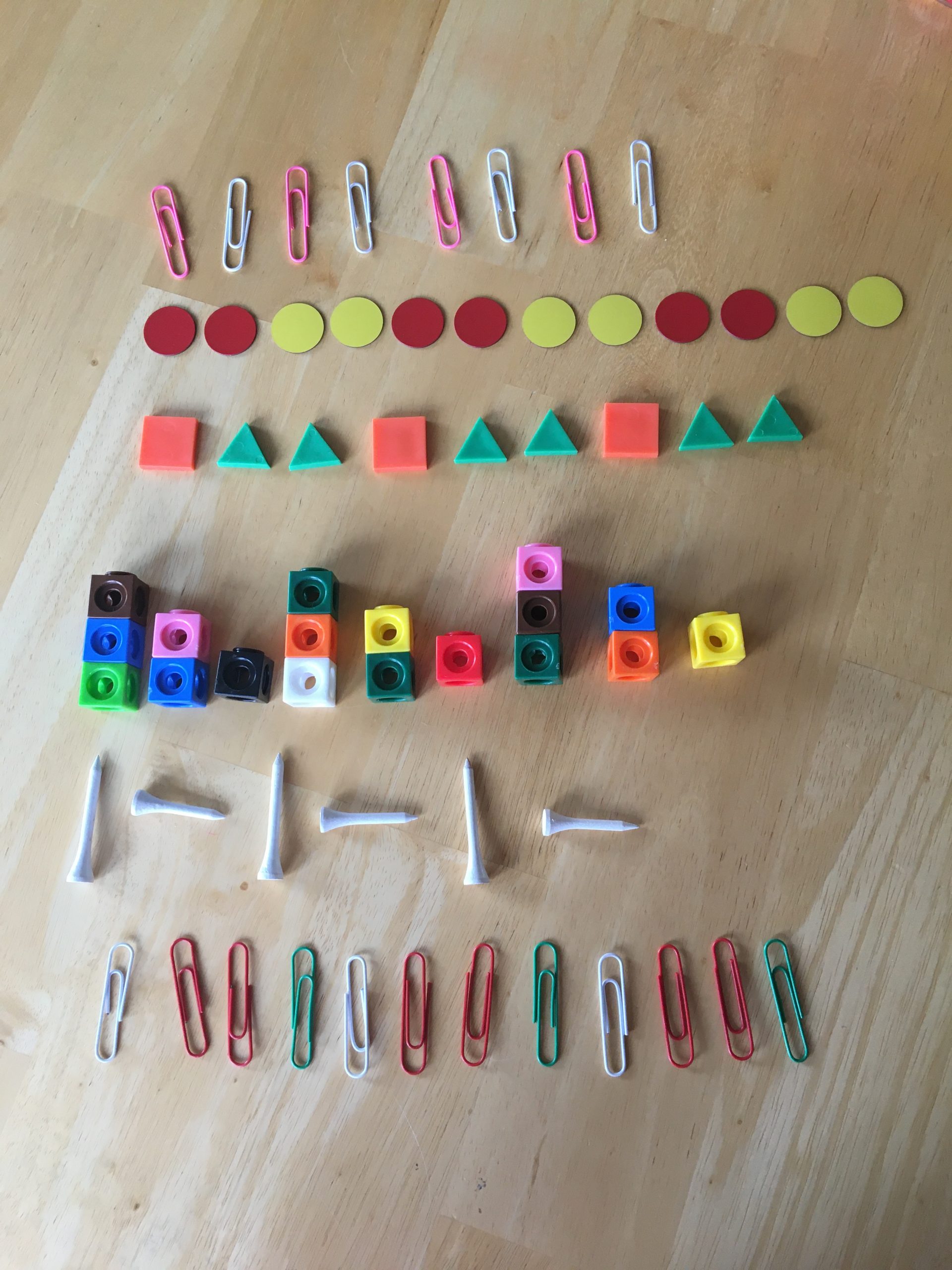
Finding and making patters is a fabulous math activity to do with your young children. Patterning is tied to the study of mathematics in a number of ways:
- Patterns regularly occur in mathematics.
- Patterns can be recognized, extended, and generalized.
- The same pattern can be found/created in many different forms.
- Patterns can occur in the physical environment, and in geometric situations as well as in numbers.
Patterning lays the foundation for algebraic thinking, particularly in representing, generalizing, and formalizing patterns. Algebra is considered to be one of the main content standards in mathematics, so helping children navigate the waters of patterning when they are young lays a good foundation for the algebra that most of us identify with in later schooling.
REPEATING PATTERNS
We will begin talking about simple patterns which are appropriate for young ones. Children love to work with materials to create patterns and for early learners is should definitely be “hands on”. There are dozens of items in your home which can be used to make patterns: blocks, buttons, silverware, shoes, pens, toys, candies (e.g., M&M’s or Skittles), toothpicks, bread tags, shapes cut from paper, and cans to name just a few. I used a number of different items to create patterns in the picture above.
Some terms to know:
Each item in a pattern is considered to be an
element.
The
core of a repeating pattern is the shortest sting of elements that repeat.
Each repetition of the core can be referred to as an
iteration.
An important aspect of patterning for young children is to be able to recognize or identify that a pattern exists. Just saying the pattern out loud (e.g., red, blue, red, blue, red, blue…) is a part of this recognition.
From there, extending a pattern is an important process in algebraic thinking. When patterns are built with materials, children are able to test their ideas for extending a pattern and make changes without fear of being wrong.
Make lots of different patterns with lots of different materials!
NAMING PATTERNS
Eventually you can compare patterns and begin to name them. Patterns are identified by using letters, one for each different element in the core of the pattern.
Looking at the picture, let’s name each pattern.
- AB (A for the pink paperclip, B for the white paperclip)
- AABB (A’s for each red circle, B’s for each yellow circle)
- ABB (A for the square, B’s for the triangles)
- ABC (A for a stack of 3, B for a stack of 2, C for the single)
- AB (A for the vertical tee, B for the horizontal tee)
- ABBC (A for the white paperclip, B’s for the red paperclips, C for the green paperclip)
You can “read” the whole pattern across with the letter names. For example, the pattern of circles can be read A-A-B-B-A-A-B-B-A-A-B-B
Did you notice that there are two patterns of the same name? You can practice making patterns with the same name out of different material.
PATTERN ACTIVITIES
Patterns can me in other ways besides building with concrete materials. Consider making up patterns using these:
- Physical movements such as (clap clap snap – AAB; hop squat twirl – ABC;
or touching shoulders, head, shoulders, knees –ABAC)
- Singing tones of the scale (do mi mi –m ABB) or making general sounds (ooh aah – AB)
ONE THING TO NOTE
It is important to note that just giving the beginning of a pattern does not define it (unless you STATE that that is the
core). In fact, when I have worked with kindergarten and grade 1 students in classrooms, one of the activities I did with them was to see how many different patterns that we could make given a certain beginning. For instance, with one group I told them that a pattern began “red, blue, green” and asked them to make a pattern that started that way. Their responses included these:
- red blue green red blue green red blue green
- red blue green blue red blue green blue red blue green blue
- red blue green green blue red red blue green green blue red red
- red blue green green red blue green green red blue green green
- red blue green yellow red blue green yellow red blue green yellow
You can see that just by giving a beginning, the pattern is not clearly defined.
FINDING PATTERNS IN YOUR ENVIRONMENT
Be sure to look for patterns in your home or neighborhood. Maybe someone is wearing a shirt with a striped pattern. Is there a pattern in the tiles of the backsplash? What about the fence outside? And of course you can make them in everyday life (with fruits and/or veggies maybe?
Patterns are everywhere and can be made with just about anything! Have fun finding and making patterns with your young children!
Mathematically yours,
Carollee

 Finding and making patters is a fabulous math activity to do with your young children. Patterning is tied to the study of mathematics in a number of ways:
Finding and making patters is a fabulous math activity to do with your young children. Patterning is tied to the study of mathematics in a number of ways:
